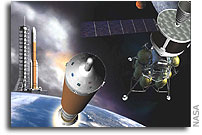Full Text of NASA Exploration Systems Architecture Study (ESAS) Final Report

Editor’s note: Last week we posted a final (October 2005) draft of this report. We have since come across the final version of the report (November 2005) which has recently been approved by NASA Administrator Michael Griffin. In order to present the most accurate version of this report, we have removed the draft version and replaced it with the complete text of the final version of the report. NASA is expected to publicly release this report in early January 2006.
Preface
The National Aeronautics and Space Administration’s (NASA’s) Exploration Systems Architecture Study (ESAS) Final Report documents the analyses and findings of the 90-day Agency-wide study. Work on this study began in May 2005 and was completed in July 2005. The purpose of the study was to:
- Assess the top-level Crew Exploration Vehicle (CEV) requirements and plans that will enable the CEV to provide crew transport to the International Space Station (ISS) and will accelerate the development of the CEV and crew launch system to reduce the gap between Shuttle retirement and CEV Initial Operational Capability (IOC);
- Define the top-level requirements and configurations for crew and cargo launch systems to support the lunar and Mars exploration programs;
- Develop a reference exploration architecture concept to support sustained human and robotic lunar exploration operations; and
- Identify key technologies required to enable and significantly enhance these reference exploration systems and a reprioritization of near-term and far-term technology investments.
The ESAS Final Report presents analysis and recommendations concerning technologies and potential approaches related to NASA’s implementation of the Vision for Space Exploration. Project and contract requirements will likely be derived, in part, from the ESAS analysis and recommendations. However, the analysis and recommendations contained herein do not represent a set of project or contract requirements and are not binding on the U.S. Government unless and until they are formally and expressly adopted as such.
Details of any recommendations offered by the ESAS Final Report will be translated into implementation requirements. Moreover, the report represents the assessments and projections of the report’s authors at the time it was prepared. It is anticipated that the concepts in this report will be analyzed further and refined. By the time some of the activities addressed in this report are implemented, certain assumptions on which the report’s conclusions are based will likely evolve based on this new analysis. Accordingly, NASA, and any entity under contract with NASA, should not use the information in this report as final project direction. The ESAS Final Report is separated into two segments. The first segment, which is the main body of the report, includes the Executive Summary. This segment is intended for public distribution.
The second segment is a collection of appendices. Access to the appendices is restricted due to the sensitive nature of the data they contain.
Table of Contents
This large 50 MB PDF report has been subdivided into 17 PDF files – one for each of the report’s 17 sections. Click on the link at the top of each section to visit a summary page and to download that section.
Editor’s note: several days ago we posted a final (October 2005) draft of this report. We have since come across a complete copy of the final version of the report (November 2005) which has recently been approved by NASA Administrator Michael Griffin. In order to present the most accurate version of this report, we have removed the draft version and replaced it with the final version of the report. NASA is expected to publicly release this report in early January 2006.
- 1. Executive Summary
- 2. Introduction
- 3. Ground Rules and Assumptions
- 4. Lunar Architecture
- 5. Crew Exploration Vehicle
- 6. Launch Vehicles and Earth Departure Stages
- 7. Operations
- 8. Risk and Reliability
- 9. Technology Assessment
- 10. Test and Evaluation
- 11. Integrated Master Schedule
- 12. Cost
- 13. Summary and Recommendations
- 14. Architecture Roadmap
- 15. Architecture Advantages
- 16. ESAS Core Team Members
- 17. Acronyms and Abbreviations








